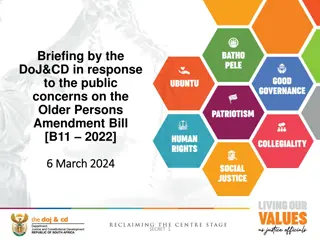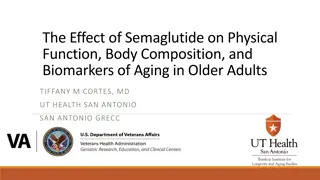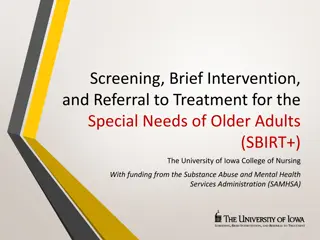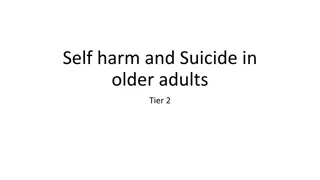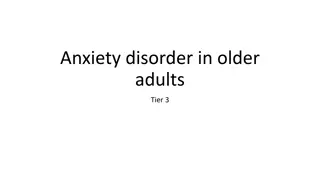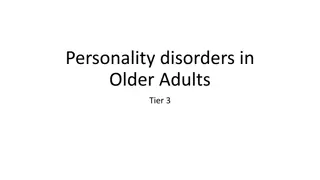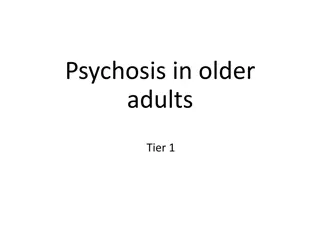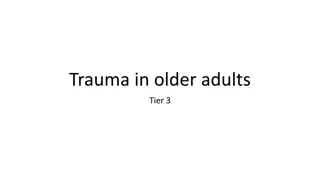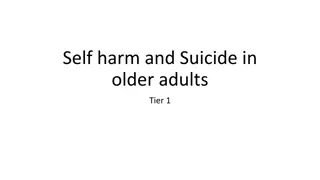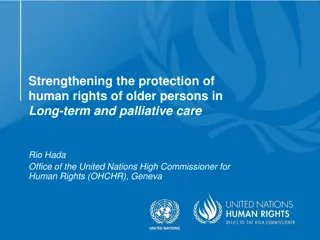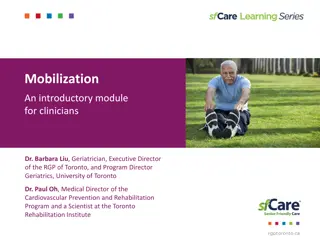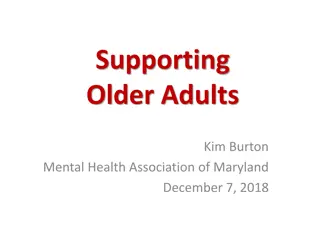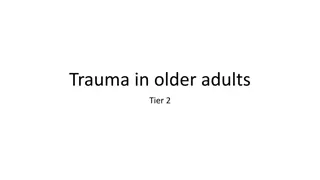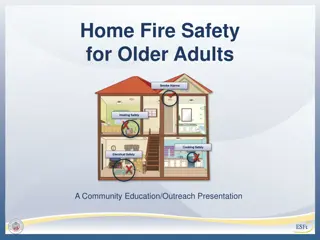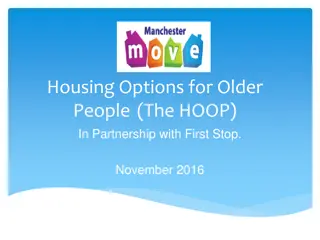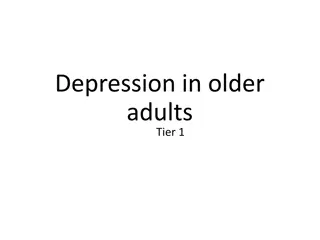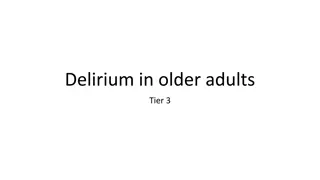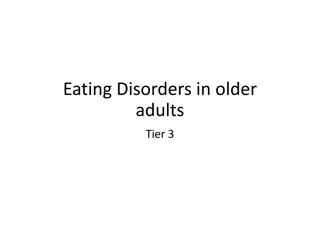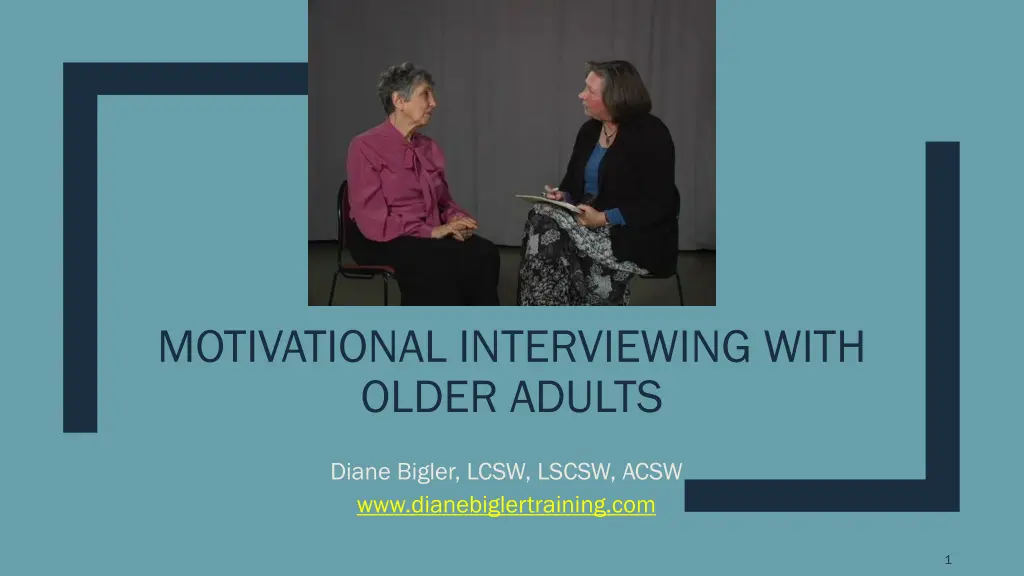
Effective Communication and Behavior Change Techniques for Older Adults
Explore motivational interviewing techniques for older adults to enhance communication, assess readiness for change, and promote behavior change. Learn about the effectiveness of Motivational Interviewing (MI) in various healthcare scenarios and its impact on medication adherence, mood improvement, and anxiety reduction among older adults.
Download Presentation

Please find below an Image/Link to download the presentation.
The content on the website is provided AS IS for your information and personal use only. It may not be sold, licensed, or shared on other websites without obtaining consent from the author. If you encounter any issues during the download, it is possible that the publisher has removed the file from their server.
You are allowed to download the files provided on this website for personal or commercial use, subject to the condition that they are used lawfully. All files are the property of their respective owners.
The content on the website is provided AS IS for your information and personal use only. It may not be sold, licensed, or shared on other websites without obtaining consent from the author.
E N D
Presentation Transcript
MOTIVATIONAL INTERVIEWING WITH OLDER ADULTS Diane Bigler, LCSW, LSCSW, ACSW www.dianebiglertraining.com 1
Learning Objectives Identify at least three approaches to effective communication. Assess a patient s readiness to change. Utilize constructive dialogue with patients about behavior change. Identify two Motivational Interviewing skills that can be used in practice with older adults. 2
What is Motivational Interviewing (MI)? A person-centered, directive method of communication for enhancing intrinsic motivation to change by helping clients explore and resolve ambivalence. - Miller & Rollnick (2002) 3
Typical Steps in Traditional Provider Approaches Explain/persuade why the client should be doing the behavior Emphasize any negative consequences Find out what the issue is Give 3 benefits for change Give advice about how to do it Gain consensus about a plan 4
Video: Spirit of MI Why Use MI? https://youtu.be/APPoK vTPhog First meeting matters MI + Active treatment/interventions is highly successful MI is not a treatment, or an intervention, or a therapy model Bigger effect with minority samples than with White/Anglo samples Broadly applicable Increased treatment retention Increased treatment adherence 5
Studies of Interest There are few randomized- controlled trials of MI with older adults MI & Cardiac Care (Watkins et al, 2007) n = 411 MI leads to improvement in patient mood three months post stroke Adherence to Medication (Solomon et al, 2010) n = 879 MI leads to improved medication adherence for people with osteoporosis Anxiety in older adults (Stanley et al, 2009) n = 134 CBT with MI resulted in greater improvement in worry severity, depressive symptoms and general mental health 6
MI Usefulness in Geriatrics Using a walker Moving into assisted living Stopping driving Decreasing drinking or drug use Hoarding Attending day care Family relationships Medication/treatment adherence End-of-life discussions 7
Video: MI for Smoking https://youtu.be/wCbY XsQd9u8 MI with Older Adults MI is particularly useful with older adults because they have multiple problems and treatment regimens that can be difficult to cope with. Consider using MI with an older adult when they are ambivalent or struggling with making necessary changes to deal with medical problems and treatments. Be flexible and work with the client in ways that meet their needs. 8
Behavior Focus There are 95+ articles on pain and MI Medication Management Therapy Exercise Opioid use Workman s Compensation Rheumatoid Arthritis Post-surgical pain Long Covid Chronic Pain Fibromyalgia Pain management Cancer pain Pain in childhood Musculoskelatal pain 9
Communication Styles in Behavioral Counseling Following Client is allowed to lead the conversation, i.e. talk therapy The clinician follows the conversation and strives to understand it Directing Clinician leads the conversation by providing clients with information or directing them to do something Guiding Client and clinician work together Clinician provides support, encouragement and assistance. 10
Video: Stages of Change Exploring Ambivalence https://link.springer.com/chap ter/10.1007/978-3-319- 16095-5_5 11
Elements of MI Conversation Ask open ended questions- Why would you want to make this change? Listen with empathy, non-judgment , reflectively Validate- affirm If you decide to make this change, how might you go about it in order to succeed? What are the 3 best reasons for you to do it? Develop discrepancy- How important would you say it is for you to make this change on a scale from 0-10? Why are you at a X rather than Y? (lower) what would it take to get you from X to Z? (higher) Summarize- did I get it all? So what do you think you ll do? 12
Readiness to Hear Stories Genuine/transparent Warmth/trustworthy Collaborate/Partner Evocation/self-story Compassion Acceptance Empathy Affirmation Absolute Worth If you re brave enough to live it, the least I can do is listen. - Ruby by Cynthia Bond, Pg 298 13
Eliciting Stories What brings you here today? When you think of , what comes to mind? What is your experience with with this situation? within the last year? over your lifetime? in your family/culture/support group? 14
PACE 15
Script Example (Medicaton): https://www.corhealthontario.ca/HMP- Counselling-Tips-Motivational-Interviewing- Case-Studies.pdf The Spirit of MI Develop Discrepancy Roll with Resistance Express Empathy Support Self-efficacy Readiness Ruler Query 16
Video: Confidence Ruler https://link.springer.com /chapter/10.1007/978- 3-319-16095-5_5 Assessing Readiness to Change On a scale of 0-10, how ready are you to think about________? 0 1 2 3 4 5 6 7 8 9 10 Backward question: Why a 5 and not a 3? Straight question: Why a 5? Forward question: What would it take for you to move from a 5 to 7? 17
Video: Importance Ruler https://link.springer.com/chapter/ 10.1007/978-3-319-16095-5_5 Importance Ruler 18
Video: Rolling with Resistance https://link.springer.com/ch apter/10.1007/978-3-319- 16095-5_5 Rolling with Resistance 19
Affirmation Examples You have a real talent for organizing and that skill seems like it helps you take your medications routinely! It took courage to take this big step in coming here today. You re clearly a resourceful person, to cope with such difficulties for so long. You re a warrior by fighting for a program that works best for you. I m glad you came, I ve enjoyed talking with you today. 20
Exercise: Find the Affirmations My joints are so swollen sometimes. At times it just hurts to move. Other times, they are just the way they are and I have learned to do things despite the difficulty. Sometimes I have trouble sleeping because of it. I don t like taking pain or sleeping pills, but I m needing something. I m generally healthy and active. Sometimes, it is harder to move, but I eat right and do things with my family. I m missing working on my crafts and quilting and feel like I m missing out when I can t work on something with my artsy friends. When I m tired or in pain, I feel crankier and that can mess up time spent with friends or family and then I feel cranky and lonely. 21
Video: OARS OARS Approach O Open-ended questions https://link.springer.com/chapter/1 0.1007/978-3-319-16095-5_5 A question that invites the client to ponder and share information. In what ways do you believe that your family is controlling you? A Affirming statements To support and encourage; recognize that which is good. It s great that you voiced your wishes to the doctor. Designed to clarify understanding and allow the client to hear what they have said. It sounds like you re not comfortable having Mary as a roommate. Reflections that pull together what a client has told you. So far you have shared that you believe your family is controlling where you live. You have also shared your preferences with your doctor. I also hear that you re not comfortable having Mary as a roommate any longer. R Reflective listening S Summarizing 22
Diversity considerations: MI with older adults Slower pace Repetition may be needed Use white boards, paper for clients who are hard of hearing Avoid elder speak More work is needed to identify adaptations of MI that might be beneficial for older adults who have distinctive needs (e.g. dysthymia, mild cognitive impairment, speech difficulties) and in different settings (e.g. primary and specialty care, long-term care). 23
Video: MI w/Older Adults at Risk for Falls https://youtu.be/IZR4Njufxs4 24
What About Relapse and Maintenance? RELAPSE MAINTENANCE Video: Video: Relapse and Making a New Plan https://link.springer.com/ch apter/10.1007/978-3-319- 16095-5_5 Maintenance https://link.springer.com/ chapter/10.1007/978-3- 319-16095-5_5 25
Case Example: How Would You Respond? Emma Emma is a 76 year-old woman living on her own. She has recently been diagnosed with Hoarding Disorder, and her home reflects this diagnosis; with little floor space, rotting, trash, and mostly unusable utilities. Emma s family is fed up with her hoarding and are not visiting her that much. Today, you are meeting with Emma for the first visit. Emma tells you I don t know why my family is so upset. This is my home and I can live as I please. I don t even know how to clean up my house it s in too bad of shape. Write down the following: An appropriate MI-based response A non-appropriate response that indicates advice giving, judging, challenging, etc. 26
In Summary Motivational interviewing is a technique used to explore ambivalence about a behavior, such as physical activity. Motivational interviewing uses open-ended questions, affirmations, reflections, and summarizations to help an older person self-analyze their behavior. To increase client success, avoid: judging/blaming, advice giving, the righting reflex, and assuming the role of expert. The effects of motivational interviewing may be greater if the clinician adheres to the core components of motivational interviewing. 27
Helpful Resources MI with Older adults article: https://cdn2.psychologytoday.com/assets/motivational_interviewing_with_older_adu.pdf MI case studies: https://www.corhealthontario.ca/HMP-Counselling-Tips-Motivational-Interviewing-Case- Studies.pdf MI script example (Diabetes, rolling w/resistance): https://www.corhealthontario.ca/HMP-Counselling-Tips- Motivational-Interviewing-Case-Studies.pdf MI with Alcohol-involved Older Adults article: file:///C:/Users/Diane%20Bigler/Downloads/Hanson_et.al.%20(1).pdf Building MI Skills workbook (300+ pages!): https://cdn.mednet.co.il/2017/11/Building-Motivational- Interviewing-Skills.pdf MI Resource Guide: https://www.communitycarenc.org/sites/default/files/2017-10/MI_Resource_Guide- updated-October-2017.pdf 18 MI Worksheets & Activities (Positive Psychology): https://positivepsychology.com/motivational- interviewing-worksheets/ 28


